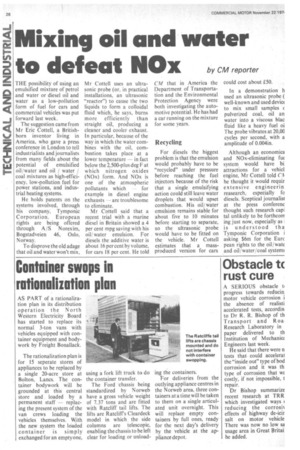Mixing oil and water
Page 30

If you've noticed an error in this article please click here to report it so we can fix it.
to defeat 110x by CM reporter
THE possibility of using an emulsified mixture of petrol and water or diesel oil and water as a low-pollution form of fuel for cars and commercial vehicles was put forward last week.
The suggestion came from Mr Eric Cottell, a Britishborn inventor living in America, who gave a press conference in London to tell industrialists and journalists from many fields about the potential of emulsified oil /water and oil / water / coal mixtures as high-efficiency, low-pollution fuel for power stations, and industrial heating systems.
He holds patents on the systems involved, through his company, Tymponic Corporation. European rights are being offered through A /S Norexim, Bogstadveien 46, Oslo, Norway.
To disprove the old adage that oil and water won't mix, Mr Cottell uses an ultrasonic probe (or, in practical installations, an ultrasonic "reactor") to cause the two liquids to form a colloidal fluid which, he says, burns more efficiently than straight oil, producing a cleaner and cooler exhaust. In particular, because of the way in which the water combines with the oil, combustion takes place at a lower temperature — in fact below the 2,500-plus deg F at which nitrogen oxides (N0x) form. And NOx is one of the atmospheric pollutants which for example in diesel engine exhausts – are troublesome to eliminate.
Mr Cottell said that a recent trial with a marine diesel in Britain showed a 4 per cent mpg saving with his oil/water emulsion. For diesels the additive water is about 16 per cent by volume, for cars 18 per cent. He told
CAI that in America the Department of Transportation and the Environmental Protection Agency were both investigating the automotive potential. He has had a car running on the mixture for some years.
Recycling
For diesels the biggest problem is that the emulsion would probably have to be "recycled" under pressure before reaching the fuel injectors because of the risk that a single emulsifying action could still leave water droplets that would upset combustion. His oil/ water emulsion remains stable for about five to 10 minutes before starting to separate, so the ultrasonic probe would have to be fitted on the vehicle. Mr Cottell estimates that a massproduced version for cars could cost about £50.
In a demonstration h used an ultrasonic probe ( well-known and used device to mix small samples ( pulverized coal, oil an water into a viscous blac fluid like a heavy fuel oi The probe vibrates at 20,00 cycles per second, with a amplitude of 0.004in.
Although an economica and NOx-eliminating fue system would have bi. attractions for a vehicl engine, Mr Cottell told CA he thought it would requir extensive engineerin reasearch, especially fa diesels. Sceptical journalisi at the press conferenc thought such research capi tal unlikely to be forthcorn ing just now, especially as : is understood tha Tymponic Corporation i asking $6m for the Eurc pean rights to the oil/ wate and oil/water/coal systems




















































































































